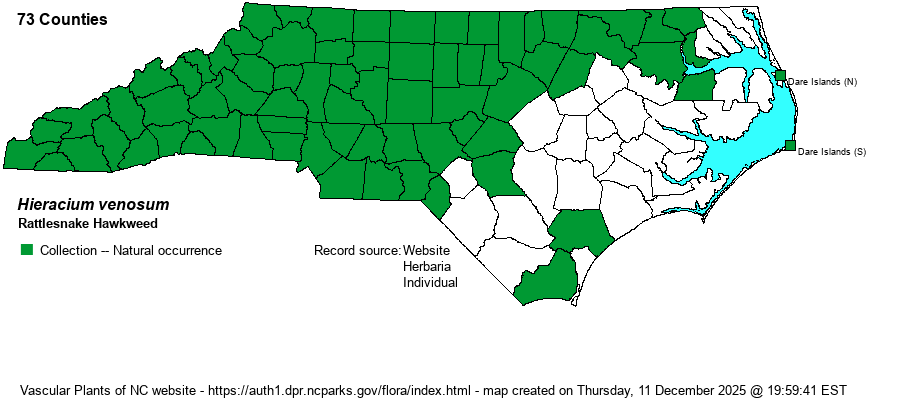| Author | L. | |
| Distribution | Mountains, Piedmont, and northern Coastal Plain; scarce in the Sandhills proper; along the Cape Fear River in Cumberland and Brunswick counties; in a "savanna just north of Ward's Corner" in Pender County.
ME to southern Ont., south to GA, MS, OK, and MO. | |
| Abundance | Common and widespread in the Piedmont and nearly all of the Mountains. Also reasonably common in the northern Coastal Plain, but infrequent in the Sandhills, and very rare to absent over most of the central and southern Coastal Plain. | |
| Habitat | Dry to mesic woodlands and forests, openings and edges of such forests, rocky slopes, oak-hickory-dogwood slopes, barrens, and roadbanks. |
| Phenology | Flowering and fruiting April-July (reportedly to September). | |
| Identification | With its red-purple (or brown-purple) leaf veins on the basal leaves (in a rosette), near lack of stem leaves, and mostly spring to early summer flowering, Rattlesnake Hawkweed is highly distinct. As with other hawkweeds, the flowers have rays florets only and are yellow in color. However, the flowers are not needed to identify this characteristic plant of dry banks and open, rocky woods. | |
| Taxonomic Comments | It reportedly hybridizes with Beaked Hawkweed; the more-or-less stabilized product is Maryland Hawkweed (H. marianum).
| |
| Other Common Name(s) | Veiny Hawkweed, Rattlesnake-weed, Robin's-plantain (generally used for Erigeron pulchellus) | |
| State Rank | S5 | |
| Global Rank | G5 | |
| State Status | | |
| US Status | | |
| USACE-agcp | | |
| USACE-emp | | |

